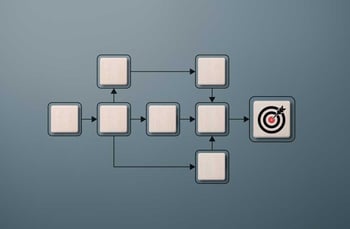Ideas like B2B integration are increasingly key components as firms struggle to prosper in constantly changing business systems. They assist firms intending to augment their operational efficiency while addressing the necessities of an interconnected digital realm.
This comprehensive guide delves into the intricacies of B2B integration, unravelling its meanings, relevance, and prime features. Read on to learn more about the importance of B2B integration and how it may improve channels of communication, streamline teamwork, and eventually promote operational efficiency.
What is B2B Integration?
B2B Integration:
Business-to-business (B2B) integration is a strategic approach that revolves around the seamless collaboration and automation of transactions between different businesses. This collaborative effort aims to streamline and facilitate various aspects of transactions, encompassing the exchange of documents and data through electronic media. B2B integration is not limited to a single transaction but extends to encompass a broad spectrum of interactions that involve internal and external systems.
At its core, B2B integration is about enhancing communication channels between businesses, leading to effective collaboration and improved productivity. Through the automation of processes, B2B integration minimizes manual interference, reducing the likelihood of errors and enhancing overall operational efficiency. The goal is to create a cohesive environment where diverse information can be gathered effortlessly, fostering a smooth flow of transactions between companies.
The use of electronic media for document and data exchanges is pivotal in B2B integration, ensuring that information can be shared rapidly and accurately. This can include electronic data interchange (EDI), where standardized formats are used for the structured exchange of business documents.
By integrating separate systems, B2B integration contributes to a more cohesive business ecosystem where partners can collaborate seamlessly, creating a foundation for sustained growth and development.
Relevance in the Digital Age:

In an era dominated by digital transformation, the integration of B2B becomes a strategic imperative. The digital realm necessitates swift and efficient communication between businesses and consumers.
Prime Features of Integration:
A comprehensive understanding of B2B integration reveals several prime features that contribute to its significance. Interconnectivity is a cornerstone, fostering a seamless flow of information between various stakeholders.
Automation plays a pivotal role, streamlining repetitive tasks and allowing resources to focus on strategic initiatives. Data analytics emerges as a powerful tool, providing insights into market trends, consumer behaviour, and operational efficiency.
What is a B2B EDI Integration Scenario?
B2B EDI Integration:
Electronic data interchange (EDI) is critical in B2B integration. B2B EDI integration entails the electronic exchange of business documents in a standardized format, which eliminates the need for manual data entry while also decreasing errors. The goal of this integration project is to digitize and automate essential business operations, thereby increasing the speed and accuracy of transactions between trading business partners.
Critical Components of B2B EDI Integration Project:
- B2B Integration Platform: A centralized platform that allows trading partners to exchange EDI documents. This platform acts as a central location for managing, translating, and routing EDI transactions.
- B2B Integration Tools: Tools and software solutions (such as applications, B2B APIs and more) meant to simplify the process integration by assuring system compatibility and smooth communication.
- B2B Data Integration: The smooth integration of data from several sources allows businesses to get valuable insights and make sound decisions.
- B2B Ecommerce ERP Integration: Synchronising data and streamlining order processing, inventory management, and financial operations by integrating e-commerce platforms with RP systems. (Enterprise Resource Planning)
Benefits of B2B Integration:
Enhanced Efficiency

B2B integration eliminates manual involvement, streamlines operations, and speeds up managed file transfer. This results in speedier order fulfillment, increased supply chain visibility, and greater operational efficiency.
Cost reductions
By infusing efficiency and precision into daily operations, automation and optimization of key business processes play a critical role in driving cost reductions. Organizations can dramatically reduce errors caused by manual interventions by employing technology to manage repetitive operations.
This reduction in errors not only improves overall process accuracy but also reduces the possible expenses associated with correcting mistakes.
Improved Accuracy
In the commercial landscape, B2B integration is a vital answer, delivering a transformative strategy that eliminates the risky hazards associated with manual data entry. This revolutionary procedure acts as a stronghold against errors, maintaining an uncompromising dedication to precision and uniformity across interrelated systems.
Visibility
Real-time visibility has become a cornerstone for modern enterprises, providing a thorough view of crucial aspects such as the supply chain, inventory levels, and order statuses. In a dynamic and competitive market context, this vital insight enables organizations to make proactive, data-driven decisions and execute responsive actions.
Competitive edge
In today's dynamic and ever-changing business landscape, firms who have strong Business-to-Business (B2B) integration skills are better positioned to handle market demands with unprecedented agility, securing a considerable competitive edge.
B2B integration entails the smooth interchange of information and transactions between companies, promoting efficient collaboration and streamlined procedures.
B2B Integration Examples:
- Supply Chain Integration:
B2B integration allows suppliers, manufacturers, and distributors to collaborate seamlessly, optimizing the supply chain for on-time production and delivery. - Vendor Management:
Businesses can work with vendors to automate the procurement business process, assuring on-time purchasing, invoicing, and inventory management. - Financial Integration:
B2B integration includes financial procedures such as electronic invoicing, payment reconciliation, and financial reporting. - CRM Integration:
Integrating client Relationship Management (CRM) systems with business-to-business (B2B) procedures improves client interactions and allows organizations to provide personalized web services.
B2B Integration Solutions and Services:
- B2B Integration Platforms:
Provide a centralized system for managing, monitoring, and optimizing business to business integration. These platforms allow trading partners to communicate in real-time. - B2B Integration Services:
Professional web services to help firms implement, manage, and optimize B2B connectivity. Consulting, B2B system integration, and continuous support are examples of these services. - Cloud-Based B2B Integration:
Using cloud technology for B2B integration increases scalability, flexibility, and accessibility, allowing firms to respond to changing needs.
B2B Integration's Powerhouse Capabilities
B2B integration is at the cutting edge of modern business dynamics, providing a set of essential features that transform how organizations function and cooperate. B2B integration is a transformative function at its core, smoothly weaving together different threads of data, systems, and applications.
Here's an in-depth examination of its primary capabilities:
- Data Formats Harmonisation:
By smoothly integrating systems information from disparate databases, B2B integration serves as a unifying force in the expansive universe of data. It overcomes the difficulties created by various data sources, allowing enterprises to create a unified and integrated data environment.
This convergence creates the groundwork for informed decision-making, providing organizations with a thorough understanding of their operations. - Managing System Synchronicity:
The capacity to orchestrate the synchrony of systems and software applications is at the heart of B2B integration. It overcomes the restrictions of isolated silos, resulting in a symphony in which multiple systems connect and collaborate effortlessly.
This orchestration improves operational efficiency by creating a dynamic environment in which processes flow smoothly from one system to the next. - Increasing Data Visibility:
Visibility is critical in the intricate web of company processes. B2B integration shines a light on the dark corners of operational procedures. It gives businesses a bird's-eye view of their data, allowing them to gain real-time insights into transactions, supply chain operations, and other essential processes.
This increased visibility becomes a strategic advantage, allowing for proactive decision-making and responsiveness to market circumstances. - Enabling Comprehensive Reporting:
B2B integration is more than just data integration; it is also about turning raw data into meaningful insights. It promotes the development of robust and real-time reports by smoothly linking systems.
These reports go beyond data points to provide a story that supports strategic initiatives. B2B integration provides organizations with the tools they need to create compelling tales from their data, from financial analytics to operational performance. - Alchemy of Formats:
The magic of B2B integration is found in its capacity to convert data from many apps or documents into standardized formats. This functionality guarantees that communication is smooth across the business environment, removing the boundaries provided by incompatible formats.
It is the digital language translator, enabling collaboration by ensuring that information speaks a common and understandable language. - Data Integrity Gatekeeper:
In the world of data, integrity is sacred. B2B integration acts as a diligent gatekeeper, enforcing stringent data validation procedures. It assures that data flowing via networked systems is accurate, consistent, and dependable. This dedication to data integrity serves as the foundation for confidence in corporate operations, establishing the way for smooth and secure cooperation.
What is the importance of B2B integration?
Enhanced Efficiency and Automation:
B2B integration catalyses operational efficiency by automating the exchange of information between businesses. Manual processes, such as order placement, invoicing, and inventory management, are prone to errors and delays. B2B integration eliminates these inefficiencies, ensuring seamless, real-time communication and reducing the risk of errors that can lead to costly disruptions.
Streamlined Communication:
Effective communication is the lifeblood of any successful business relationship. B2B integration facilitates seamless communication by establishing standardized protocols for data exchange. This uniformity ensures that partners are on the same page, leading to faster decision-making, improved collaboration, and a more responsive supply chain.
Cost Savings:
Traditional methods of communication, such as paper-based systems and manual critical data entry, can be expensive and time-consuming. B2B integration significantly reduces costs associated with paperwork, human errors, and inefficient processes. By automating routine tasks and optimizing workflows, organizations can redirect resources towards strategic initiatives, ultimately improving their bottom line.
Real-Time Visibility:

B2B integration provides organizations with real-time visibility into their supply chain and business processes. This transparency enables better decision-making by allowing stakeholders to access accurate, up-to-date information. Businesses can respond promptly to changes in demand, monitor inventory levels, and optimize production schedules, contributing to increased agility and competitiveness.
Improved Customer Satisfaction:
The seamless flow of information enabled by B2B integration extends beyond internal processes to impact customer satisfaction. Timely and accurate order processing, fulfilment, and delivery contribute to a positive customer experience. Satisfied customers are more likely to become repeat customers, fostering long-term relationships and enhancing the reputation of the involved businesses.
Adaptability to Market Changes:
The business landscape is dynamic, with market conditions and customer demands constantly evolving. B2B integration equips organizations with the flexibility to adapt to these changes swiftly. Whether it's scaling up production in response to increased demand or adjusting inventory levels based on market trends, B2B integration empowers businesses to stay ahead of the curve.
Challenges in B2B Integration:

Starting a B2B integration project has its share of difficulties, which call for taking preventative measures to get over possible roadblocks. The following are some typical problems and solutions for them:
Interoperability problems:
B2B integration calls for a variety of systems with different formats and protocols. It is essential to provide smooth interoperability. Use standardized communication methods and spend money on middleware programs that act as a link between disparate systems.
Security Issues:
Robust security procedures are necessary when exchanging sensitive corporate data. To protect against possible breaches, put encryption, safe authentication procedures, and frequent security audits into place. To ensure the confidentiality and integrity of shared data, a thorough cybersecurity plan is essential.
Partner Onboarding Complexity:
Onboarding new partners might get more difficult as your network of partners expands. To streamline the process and cut down on manual labour, create consistent onboarding methods, provide clear documentation, and think about adopting self-service onboarding portals.
Difficulties with Data Mapping One enduring difficulty is harmonizing data formats across heterogeneous platforms. Make use of sophisticated data mapping technologies to make it easier to translate data between various formats, guaranteeing a seamless information interchange without sacrificing data accuracy.
Best Practices for Successful B2B Integration:

Implementing B2B integration successfully calls for a well-thought-out strategy. The following are essential recommended practices to help companies integrate seamlessly:
Establish Specific Goals:
Clearly state the goals that your B2B integration project is aiming to achieve. Setting clear objectives will direct the integration process, whether the objectives are to increase efficiency, decrease operating costs, or improve collaboration.
Create Standardized methods:
Ensuring consistency between partners is facilitated by standardizing communication methods. Adopt commonly used standards, such Electronic Data Interchange (EDI), to make data sharing easier and simplify integration.
Invest in Scalable Solutions:
Make sure the solutions you select will expand with your company. As the number of partners and transactions rises, scalability becomes increasingly important. This guarantees that the architecture for B2B interaction may change to meet changing business requirements.
Constant Monitoring and Optimization:
To keep tabs on the effectiveness of your B2B connection, put in place reliable monitoring tools. To improve overall efficiency, monitor data exchange patterns on a regular basis, look for bottlenecks, and optimize operations.
Future Trends in B2B Integration:

As technology advances, the B2B integration landscape is always changing. Future B2B integration will be shaped by the following key trends:
- Blockchain Integration:
Due to its capacity to offer a transparent and safe environment for transactions, blockchain technology is becoming more and more popular in B2B integration. Examine how blockchain technology might improve data integrity and trust in business-to-business partnerships. - Artificial Intelligence (AI)-Driven Integration:
AI has the potential to be a major factor in automating B2B integration decision-making processes. Large-scale dataset analysis, pattern recognition, and process optimization are all possible using AI algorithms, all of which boost productivity. - IoT Integration:
B2B processes are increasingly reliant on the Internet of Things (IoT), which provides real-time control and monitoring. Examine how B2B ecosystems can benefit from the seamless integration of IoT devices to improve visibility and make data-driven decisions. - Enhanced Data Analytics:
The extraction of useful insights from integrated data will be greatly aided by the use of advanced analytics technologies. Investigate analytics options that offer in-depth understanding of consumer behaviour, market trends, and operational performance to help in decision-making.
The Bottom Line
In conclusion, B2B integration is a cornerstone for modern businesses seeking to thrive in a dynamic and competitive environment. The importance of B2B integration extends beyond mere efficiency gains; it reshapes how organizations collaborate, communicate, and respond to market changes.
Embracing B2B integration is not just a technological upgrade; it is a strategic integration platform for the future of business networks. As industries continue to evolve, organizations that prioritize B2B integration will undoubtedly position themselves for sustained growth, improved customer satisfaction, and a competitive edge in the global marketplace.
One crucial takeaway is the importance of the integration process to facilitate integration. Whether through sophisticated software solutions, advanced data analytics, or the implementation of robust e-commerce platforms, businesses must harness the power of digital tools to streamline processes, enhance communication, and gain actionable insights into customer behavior.
Frequently Asked Questions (FAQs):
What is the Meaning of B2B Connection?
B2B Connection refers to business-to-business connections, which involve transactions, collaborations, and communication between two or more businesses. Unlike other interactions, B2B interactions focus on meeting the needs of businesses rather than individual consumers.
What is B2B Integration?
B2B Integration involves the seamless connection and collaboration between different businesses, streamlining processes like order processing, invoicing, and inventory management.
What is B2B and B2C integration?
B2B integration streamlines transactions and collaborations between businesses, optimizing operational efficiency while B2C integration focuses on enhancing interactions with individual consumers, aiming to provide personalized services and seamless online transactions.
What is a B2B EDI Integration Scenario?
B2B EDI Integration stands for Electronic Data Interchange in a business-to-business context. It involves the electronic exchange of business documents, such as invoices and purchase orders, between trading partners. This streamlines processes, reduces errors, and enhances efficiency in the supply chain.
What are the Benefits of B2B Integration?
B2B Integration provides businesses with streamlined processes, reducing manual errors and leading to cost savings, especially in order processing and inventory management. It fosters improved collaboration, enhances productivity, speeds up transactions for quicker order fulfillment, and ensures accuracy through electronic data exchange.
What are B2B Integration Examples?
B2B Integration optimizes the supply chain by enabling real-time collaboration between manufacturers, suppliers, and distributors. Electronic Data Interchange (EDI) systems facilitate seamless document exchange, streamlining procurement and order fulfillment.
What is the Importance of B2B Integration?
B2B Integration is crucial for modern businesses due to its role in fostering efficiency, reducing costs, and enhancing collaboration. It ensures that businesses can adapt to the fast-paced and dynamic nature of the global market.
What are the 2 Types of B2B Integration?
Vertical Integration involves businesses within the same industry or supply chain optimizing industry-specific processes. Horizontal Integration integrates businesses from different industries to streamline shared processes like HR or finance.





Comments